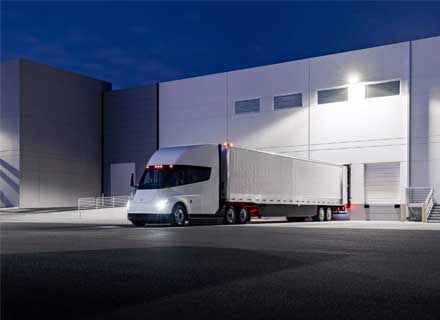According to Tesla, a version of Semi’s big electric trucks and a reasonably priced electric vehicle will both employ cheaper, iron-based batteries.
Tesla CEO Elon Musk has pushed for the usage of lithium iron phosphate (LFP) batteries, produced mainly by Chinese vendors. He claimed in March 2023 that “the vast bulk of the heavy lifting for electrification will be iron-based cells.”
However, due to the political tensions between Washington and Beijing, having Chinese suppliers develop battery manufacturing in the United States is challenging.
The largest electric vehicle manufacturer in the world stated that LFP batteries would be used for “short-range” heavy electric trucks it refers to as “Semi Light” in its paper on “Master Plan Part 3”. However, it did not provide additional information, such as a launch date.
In 2022 December, Tesla began shipping its semi-electric trucks with nickel-based batteries and a more extended 500-mile range between charges. Tesla has already declared that it will also release a model with a 300-mile range.
The company also said that compared to the 75 kWh of the Model Y and Model 3 batteries, the projected small electric vehicles would have LFP batteries with a capacity of 53 kilowatt-hours (kWh).
In March 2023, Tesla announced that it would slash assembly costs in half for the following models of vehicles that would be produced at its factories in Mexico and other countries.
Tesla stated that LFP batteries would also be used in its mid-sized Model 3 and Model Y vehicles without a timeframe.
Most of Tesla’s Model 3 and Model Y vehicles sold in the US currently have nickel-based batteries.
Elon Musk and other LFP proponents pointed to the plentiful supply and lower cost of iron as a crucial factor, thus outweighing the disadvantages preventing the widespread deployment of LFP cells. In addition, they have a lesser range than nickel-based cells since they are larger, heavier, and typically carry less energy.
Compared to nickel-based cells, LFP cells typically have a lower fire risk.
Tesla presently purchases LFP batteries from Contemporary Amperex Technology Co. in China, a company without a facility in the US. LG Energy Solution, a South Korean supplier to Tesla, announced that the envisioned Arizona factory would produce LFP batteries.
The company will be building a new battery factory in Shanghai, thus increasing its investment in China.
The construction of the facility will start in the third quarter of 2023 and plans are to have it completed by the second quarter of 2024 when production is slated to begin, suggested news reports.
The Shanghai facility will produce some 10,000 Megapacks annually, with a total capacity equivalent to 40 GWh, Tesla said.
China accounts for about a quarter of Tesla’s revenues and Shanghai is already home to the EV maker’s car factory. In February 2023, the factory rolled out close to 90,000 cars.
China reportedly has a much better-developed EV battery supply chain than the other countries, which, as per analysts, might have to do with Tesla’s decision to choose a new factory location in the world’s second-largest economy, as the country also sports lower production costs than alternatives.
Image Credits: Tesla

